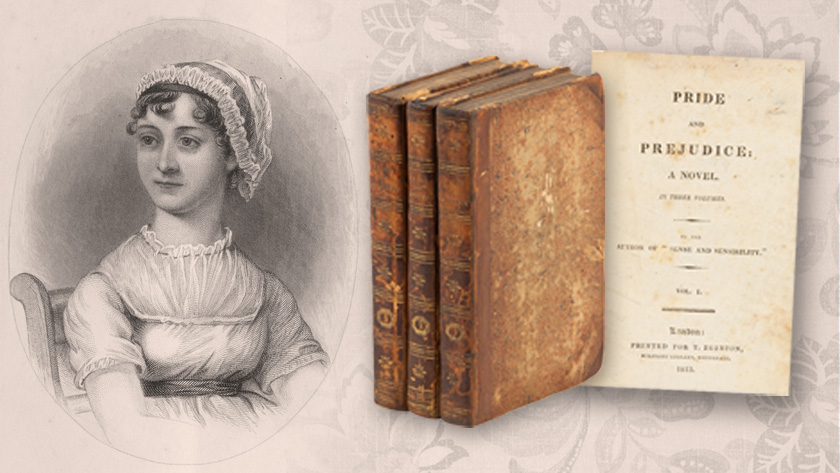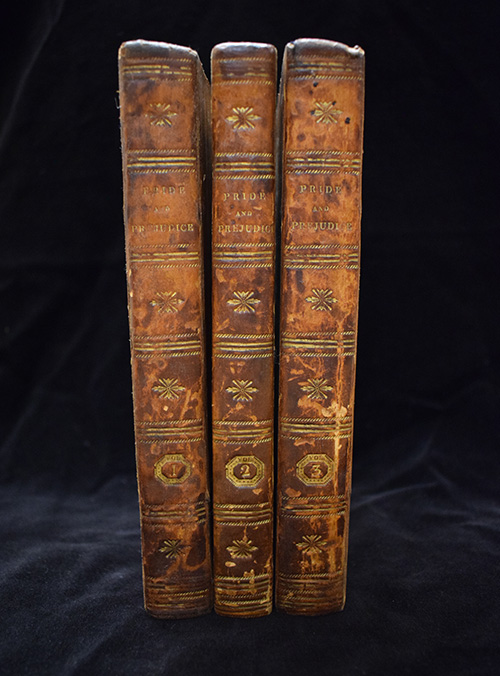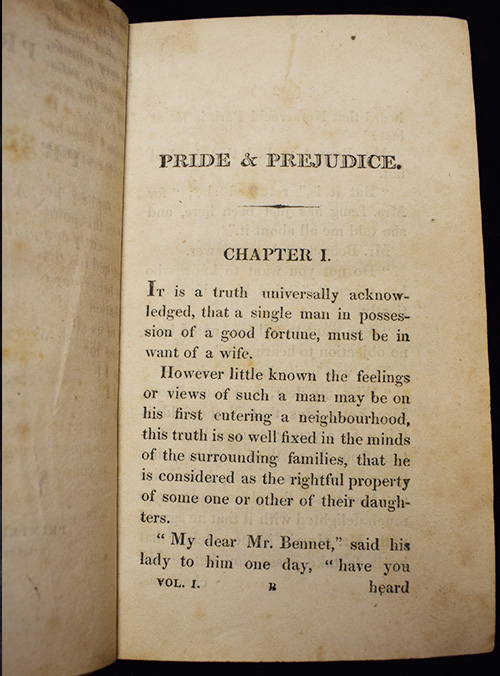
Celebrating the Acquisition of a First Edition of Pride and Prejudice
by Caroline Liebel, graduate assistant, Special Collections Mark Samuels Lasner Collection
“It is a truth universally acknowledged …” that Jane Austen’s second published book, Pride and Prejudice, remains one of the most beloved works in English literature. Published in 1813, the story of Elizabeth Bennet and Mr. Darcy has captivated readers for more than two centuries—and has inspired countless numbers of versions, ranging from illustrated editions, translations into more than forty languages, plays, radio, film and television adaptations, parodies and modernizations of multiple kinds. The popularity of Pride and Prejudice is unceasing.
Austen first drafted the novel in 1796 under the title First Impressions, but later extensively revised the manuscript in 1811-1812 and renamed it Pride and Prejudice. The first edition of approximately 1,500 copies was published in three volumes in 1813 by Thomas Egerton, who ran a “Military Library” in Whitehall, London. As with all the books published during Austen’s lifetime, her name did not appear on the title-pages; instead, authorship was attributed “by the author of Sense and Sensibility”—her first novel, published by Egerton in 1811.

About the Story
Austen’s novel of manners, set among the landed gentry in southern England, explores contemporary concerns about reputation and courtship, as well as the expectations and limitations for women. The story follows Elizabeth Bennet, a perceptive and sharp-witted young woman whose character progresses alongside her tumultuous relationship with Mr. Darcy, a wealthy landowner who lacks social graces and is often perceived as haughty and proud. As Darcy is much wealthier than the Bennet family, he must overcome his pride and Elizabeth, who often makes judgments based on first impressions, must overcome her prejudice for their relationship to succeed.

The Provenance of the Acquisition
Bound in a contemporary binding of half calf, this copy has an interesting early history. On the front endpaper of all three volumes is the name Sophia Patteson (1797-1847), a member of a notable Suffolk family with connections that parallel those of both of the characters in Pride and Prejudice and of Austin’s own relations.
Born to the Reverend Henry Patteson, a country gentleman, magistrate and the rector of two tiny villages, and Sophia Patteson (née Lee), Sophia never married. Her sister Lucy married John Chevallier Cobbold, scion of a dynasty of successful brewers and bankers in Ipswich. The Cobbold clan included the novelist Elizabeth Cobbold, multiple members of Parliament, military officers, collectors and philanthropists. It is very likely that Jane Austen’s soldier brother, Henry, became acquainted with the socially prominent Cobbolds and Pattesons when he was stationed in Ipswich for more than a year in 1797-1798. The Pattesons became allied to the distinguished Coleridge family which included the poet Samuel Taylor Coleridge when Sophia’s brother John married Frances, the daughter of John Coleridge. One of Sophia’s numerous other siblings, Anne, married the Reverend Thomas Wright Whitaker. They most likely had a daughter named Sophia K. Whitaker, who also inscribed her name in all three volumes. The most recent owner of the book was George Starr, a beloved former English professor at the University of California, Berkeley who died in August 2024. Starr was one of the world’s leading Daniel Defoe scholars and had wide-ranging book collecting interests.
We Invite You to Join Us
To mark the 250th anniversary of Austen’s birth and the recent acquisition of Pride and Prejudice, we will host Jane Austen Now: A Saturday Symposium. In addition, a pop-up exhibition in Special Collections, curated by English Ph.D. candidate Caroline Liebel, will be on display from December 2-16. The display will include first and later editions of Austen’s novels, illustrated works from the turn of the 20th century and rare related materials such as Alice Dunbar-Nelson’s essay, “Why I Love Jane Austen.”
“A View from the Vault” showcases some of the unique, notable or rare items that are a part of the Special Collections and Museums holdings at the University of Delaware. Each month, we highlight a different work and share interesting facts or intriguing histories about it. If you are interested in seeing any of the materials featured in person or want to learn more about any work showcased in the series, please contact Special Collections and Museums at AskSpec or AskMuseums.
